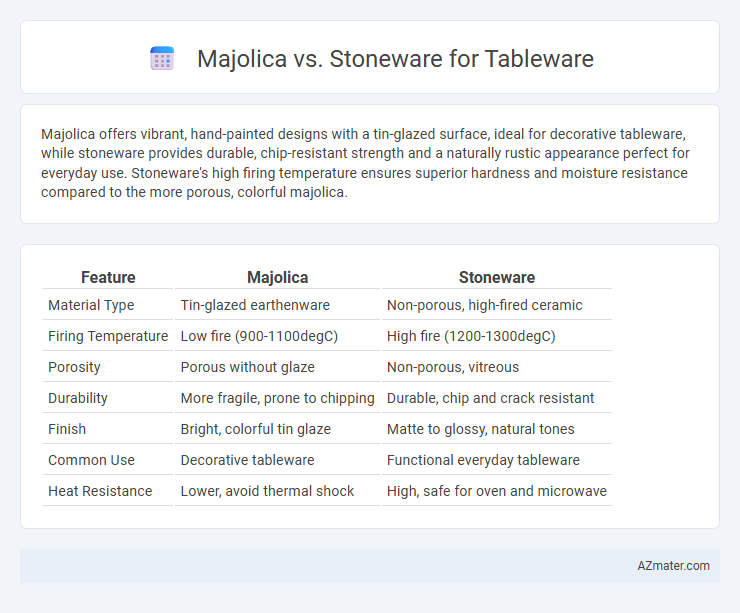Majolica offers vibrant, hand-painted designs with a tin-glazed surface, ideal for decorative tableware, while stoneware provides durable, chip-resistant strength and a naturally rustic appearance perfect for everyday use. Stoneware's high firing temperature ensures superior hardness and moisture resistance compared to the more porous, colorful majolica.
Table of Comparison
| Feature | Majolica | Stoneware |
|---|---|---|
| Material Type | Tin-glazed earthenware | Non-porous, high-fired ceramic |
| Firing Temperature | Low fire (900-1100degC) | High fire (1200-1300degC) |
| Porosity | Porous without glaze | Non-porous, vitreous |
| Durability | More fragile, prone to chipping | Durable, chip and crack resistant |
| Finish | Bright, colorful tin glaze | Matte to glossy, natural tones |
| Common Use | Decorative tableware | Functional everyday tableware |
| Heat Resistance | Lower, avoid thermal shock | High, safe for oven and microwave |
Introduction to Majolica and Stoneware Tableware
Majolica tableware features a tin-glazed earthenware surface with vibrant, hand-painted designs that offer a decorative and colorful aesthetic ideal for casual and formal dining. Stoneware is a durable, non-porous ceramic fired at high temperatures, known for its strength and earthy, often matte finishes that withstand everyday use and resist chipping. Both materials provide unique textures and durability, but Majolica excels in artistic expression while stoneware prioritizes functionality and resilience.
Historical Origins of Majolica and Stoneware
Majolica originated in the Renaissance period, characterized by its vibrant tin-glazed pottery developed in Italy, often decorated with intricate Renaissance motifs. Stoneware dates back to ancient Asia and Europe, known for its durable, dense, and non-porous qualities fired at high temperatures, making it ideal for everyday use. These historical origins highlight majolica's decorative artistry contrasted with stoneware's functional robustness in tableware design.
Material Composition and Manufacturing Processes
Majolica tableware features a porous earthenware clay body coated with a tin glaze that creates a bright, opaque surface ideal for vibrant, hand-painted designs, while stoneware is made from a denser, vitrified clay fired at higher temperatures, resulting in a non-porous, durable finish. The manufacturing process for majolica involves a two-step firing: bisque firing the shaped clay, then applying the tin glaze and firing again at a lower temperature to preserve decorative details. Stoneware undergoes a single high-temperature firing that vitrifies the clay, enhancing strength and making it more resistant to chipping and thermal shock compared to majolica.
Visual Characteristics: Color, Glaze, and Texture
Majolica tableware showcases vibrant, hand-painted colors with a glossy, opaque tin glaze that enhances intricate patterns and artistic details. Stoneware features earthy, muted tones with a matte or semi-matte glaze that highlights natural textures and a heavier, robust feel. The smooth, reflective surface of majolica contrasts with the rustic, tactile finish typical of stoneware, making each ideal for different aesthetic preferences.
Durability and Everyday Usability
Stoneware offers superior durability compared to Majolica, making it ideal for everyday tableware use due to its resistance to chipping, scratching, and thermal shocks. Majolica, characterized by its colorful glaze and intricate designs, is more prone to chipping and may require delicate handling, limiting its practicality for daily use. For households seeking robust, low-maintenance dinnerware with longevity, stoneware provides a more reliable option.
Heat and Stain Resistance Comparison
Stoneware offers superior heat resistance, tolerating high oven temperatures without cracking, making it ideal for baking and serving hot dishes. Majolica, characterized by its porous earthenware base and tin-glazed surface, is less heat resistant and can suffer damage from sudden temperature changes. Stoneware also resists stains more effectively due to its dense, vitrified body, whereas Majolica's glaze can absorb stains and discolor over time with regular use.
Maintenance and Care Requirements
Majolica tableware requires gentle hand washing with mild detergents to preserve its delicate glaze and vibrant colors, avoiding abrasive materials that can cause chipping. Stoneware is more durable and dishwasher-safe, offering resistance to scratches and thermal shock, making it easier to maintain for everyday use. Proper drying of both materials is essential to prevent moisture absorption and potential cracking over time.
Cost and Value for Buyers
Majolica tableware typically carries a higher price due to its intricate hand-painted designs and delicate glazing process, appealing to buyers seeking decorative appeal and artisanal value. Stoneware offers a more affordable and durable option, often preferred for everyday use because of its chip-resistant qualities and heat retention. Buyers focused on cost-efficiency and longevity generally find stoneware provides better value, while collectors and those prioritizing aesthetic uniqueness lean toward Majolica despite the premium.
Popular Uses in Modern Table Settings
Majolica, known for its vibrant glazed surfaces and intricate patterns, is popular in modern table settings as decorative serving dishes and colorful accent pieces. Stoneware, prized for its durability and natural earthy tones, is frequently used for everyday dinnerware, including plates, bowls, and mugs, offering a rustic yet sophisticated aesthetic. Contemporary tableware designs often combine the artistic flair of majolica with the practicality of stoneware to create visually appealing and functional dining experiences.
Choosing the Best Option: Majolica or Stoneware?
Majolica offers vibrant, hand-painted designs with a translucent glaze that enhances visual appeal, making it ideal for decorative tableware. Stoneware provides superior durability and chip resistance with a dense, non-porous structure, perfect for everyday use and heavy handling. Choosing between majolica and stoneware depends on whether aesthetic detail or functional toughness is the priority for your tableware needs.

Infographic: Majolica vs Stoneware for Tableware
 azmater.com
azmater.com